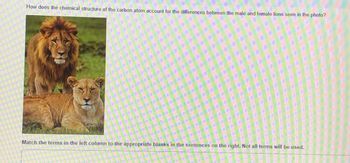
Human Anatomy & Physiology (11th Edition)
11th Edition
ISBN: 9780134580999
Author: Elaine N. Marieb, Katja N. Hoehn
Publisher: PEARSON
expand_more
expand_more
format_list_bulleted
Question

Transcribed Image Text:**Title: Exploring the Role of the Carbon Atom in Biological Differences: A Case Study of Male and Female Lions**
This educational module aims to delve into the fascinating world of biology by examining how the chemical structure of carbon atoms contributes to the observable differences between male and female lions.
**Introduction:**
The carbon atom is fundamental in the chemistry of life. By examining its role, we can understand the underlying mechanisms that lead to the various physical and functional differences between genders in the animal kingdom.
**Observation:**
In the provided photograph, we observe a male lion and a female lion.
- **Male Lion:** Characterized by a large mane surrounding its face, giving it a more imposing stature.
- **Female Lion:** Smaller in comparison, with a lack of a mane, which makes them appear less robust than their male counterparts.
**Question:**
*How does the chemical structure of the carbon atom account for the differences between the male and female lions seen in the photo?*
**Activity:**
Match the terms in the left column to the appropriate blanks in the sentences on the right. Not all terms will be used.
---
This module integrates visual and interactive learning to highlight the significance of carbon in biological diversity, specifically in gender differences among lions. Through this exercise, students will gain a deeper understanding of the biochemical underpinnings that manifest as distinct physical traits.

Transcribed Image Text:### The Versatility of Carbon in Organic Molecules
Because carbon has a valence of **4**, it can form **four covalent** bonds with other atoms. Such versatility of carbon allows for building the skeletons of organic molecules, including important biomolecules.
#### Steroids as an Example
For example, carbon skeletons in the shape of four fused rings make up **steroids**, some of which are sex hormones. Estradiol, a **female** sex hormone, and testosterone, a **male** sex hormone, are very similar in structure, differing only in **two** **chemical groups**. It leads to different **shapes and chemical characteristics**, allowing them to bind to molecules on the surface of different target cells and result in different **effects**, such as the differences between the lions in the photo.
Expert Solution
This question has been solved!
Explore an expertly crafted, step-by-step solution for a thorough understanding of key concepts.
This is a popular solution
Trending nowThis is a popular solution!
Step by stepSolved in 2 steps

Knowledge Booster
Similar questions
- I'd like you to explain to me the structure of one of your macromolecules. You should be describing the monomers, polymers, and any important chemical bonding. Carbohydratesarrow_forwardI'd like you to explain to me the structure of one of your macromolecules. You should be describing the monomers, polymers, and any important chemical bonding. Proteinarrow_forwardMacromolecules Food Example Monomer(s) contained in this food Carbohydrates Lipids Proteins Nucleic Acids N/A (in all foods)arrow_forward
- Lable out the main difference of Primary, secondary, tertiary, and quatrenary protein structure in biochemistryarrow_forwardSimple sugars Enzyme 1. Carbohydrate Steroids 2. Lipid Guanine 3. Protein 4. Nucleic Acid Triglyceride Alpha helices > > > > > >arrow_forwardThe naturally-occurring amino acid L-serine (NH2-CH(COOH)-CH2-OH, dry form) shares all of the following features with the naturally-occurring amino acid D-serine, except: the same three-dimensional arrangement of covalent bonds the same stoichiometry the same number of covalent bonds the exact same atoms the same number of atomsarrow_forward
arrow_back_ios
arrow_forward_ios
Recommended textbooks for you
 Human Anatomy & Physiology (11th Edition)BiologyISBN:9780134580999Author:Elaine N. Marieb, Katja N. HoehnPublisher:PEARSON
Human Anatomy & Physiology (11th Edition)BiologyISBN:9780134580999Author:Elaine N. Marieb, Katja N. HoehnPublisher:PEARSON Biology 2eBiologyISBN:9781947172517Author:Matthew Douglas, Jung Choi, Mary Ann ClarkPublisher:OpenStax
Biology 2eBiologyISBN:9781947172517Author:Matthew Douglas, Jung Choi, Mary Ann ClarkPublisher:OpenStax Anatomy & PhysiologyBiologyISBN:9781259398629Author:McKinley, Michael P., O'loughlin, Valerie Dean, Bidle, Theresa StouterPublisher:Mcgraw Hill Education,
Anatomy & PhysiologyBiologyISBN:9781259398629Author:McKinley, Michael P., O'loughlin, Valerie Dean, Bidle, Theresa StouterPublisher:Mcgraw Hill Education, Molecular Biology of the Cell (Sixth Edition)BiologyISBN:9780815344322Author:Bruce Alberts, Alexander D. Johnson, Julian Lewis, David Morgan, Martin Raff, Keith Roberts, Peter WalterPublisher:W. W. Norton & Company
Molecular Biology of the Cell (Sixth Edition)BiologyISBN:9780815344322Author:Bruce Alberts, Alexander D. Johnson, Julian Lewis, David Morgan, Martin Raff, Keith Roberts, Peter WalterPublisher:W. W. Norton & Company Laboratory Manual For Human Anatomy & PhysiologyBiologyISBN:9781260159363Author:Martin, Terry R., Prentice-craver, CynthiaPublisher:McGraw-Hill Publishing Co.
Laboratory Manual For Human Anatomy & PhysiologyBiologyISBN:9781260159363Author:Martin, Terry R., Prentice-craver, CynthiaPublisher:McGraw-Hill Publishing Co. Inquiry Into Life (16th Edition)BiologyISBN:9781260231700Author:Sylvia S. Mader, Michael WindelspechtPublisher:McGraw Hill Education
Inquiry Into Life (16th Edition)BiologyISBN:9781260231700Author:Sylvia S. Mader, Michael WindelspechtPublisher:McGraw Hill Education

Human Anatomy & Physiology (11th Edition)
Biology
ISBN:9780134580999
Author:Elaine N. Marieb, Katja N. Hoehn
Publisher:PEARSON

Biology 2e
Biology
ISBN:9781947172517
Author:Matthew Douglas, Jung Choi, Mary Ann Clark
Publisher:OpenStax

Anatomy & Physiology
Biology
ISBN:9781259398629
Author:McKinley, Michael P., O'loughlin, Valerie Dean, Bidle, Theresa Stouter
Publisher:Mcgraw Hill Education,

Molecular Biology of the Cell (Sixth Edition)
Biology
ISBN:9780815344322
Author:Bruce Alberts, Alexander D. Johnson, Julian Lewis, David Morgan, Martin Raff, Keith Roberts, Peter Walter
Publisher:W. W. Norton & Company

Laboratory Manual For Human Anatomy & Physiology
Biology
ISBN:9781260159363
Author:Martin, Terry R., Prentice-craver, Cynthia
Publisher:McGraw-Hill Publishing Co.

Inquiry Into Life (16th Edition)
Biology
ISBN:9781260231700
Author:Sylvia S. Mader, Michael Windelspecht
Publisher:McGraw Hill Education